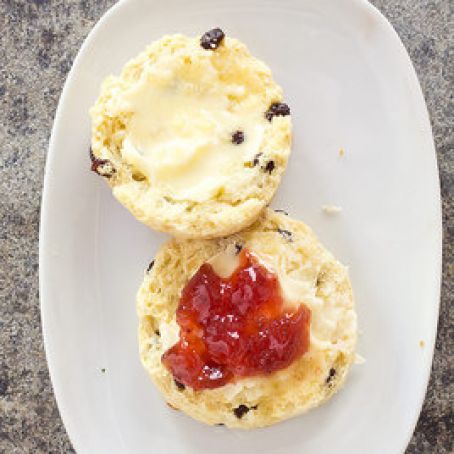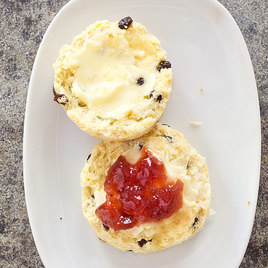British-Style Currant Scones
By DreiFromBK
British scones are not as sweet or as rich as American scones, and that makes them more suitable for serving with butter and jam. To make the lightest, fluffiest scones, we added more than the usual amount of leavening: 2 teaspoons of baking powder per cup of flour. Rather than leaving pieces of cold butter in the dry ingredients as we do for flaky biscuits, we thoroughly worked in softened butter until it was fully integrated. This protected some of the flour granules from moisture, which in turn limited gluten development and kept the crumb tender and cakey. We add currants for tiny bursts of fruit flavor and brush some reserved milk and egg on top for enhanced browning.
Makes 12 scones
We prefer whole milk in this recipe, but low-fat milk can be used. The dough will be quite soft and wet; dust your work surface and your hands liberally with flour. For a tall, even rise, use a sharp-edged biscuit cutter and push straight down; do not twist the cutter. These scones are best served fresh, but leftover scones may be stored in the freezer and reheated in a 300-degree oven for 15 minutes before serving. Serve these scones with jam as well as salted butter or clotted cream.
 1 Picture
1 Picture
Ingredients
- 3 Cups (15 ounces) all-purpose flour *
- 1/3 Cup (2 1/2 ounces) sugar
- 2 Tablespoons baking powder
- 1/2 Teaspoon salt
- 8 Tablespoons unsalted butter
- 3/4 Cup dried currants
- 1 Cup whole milk * *
- 2 Large eggs
- This dough will be quite soft and wet; keep extra flour on hand to use to dust your work surface and your hands when handling the dough.
- We prefer whole milk in this recipe, but low-fat milk can be used.
Details
Adapted from americastestkitchen.com
Preparation
Step 1
1. Cut 8 tablespoons unsalted butter into ½-inch pieces and let sit at room temperature for 30 minutes.
2. Adjust oven rack to upper-middle position and heat oven to 500 degrees.
3. Line rimmed baking sheet with parchment paper.
4. Pulse 3 cups (15 ounces) all-purpose flour, ⅓ cup (2⅓ ounces) sugar, 2 tablespoons baking powder, and ½ teaspoon salt in food processor until combined, about 5 pulses.
5. Add softened butter and pulse until fully incorporated and mixture looks like very fine crumbs with no visible butter, about 20 pulses.
6. Transfer mixture to large bowl and stir in ¾ cup dried currants.
7. Whisk 1 cup whole milk and 2 large eggs together in second bowl.
8. Set aside 2 tablespoons milk mixture.
9. Add remaining milk mixture to flour mixture and, using rubber spatula, fold together until almost no dry bits of flour remain.
10. Transfer dough to well-floured counter and gather into ball.
11. With floured hands, knead until surface is smooth and free of cracks, 25 to 30 times.
12. Press gently to form disk. Using floured rolling pin, roll disk into 9-inch round, about 1 inch thick
13. Using floured 2½-inch round cutter, stamp out 8 rounds, recoating cutter with flour if it begins to stick. Arrange scones on prepared sheet.
14. Gather dough scraps, form into ball, and knead gently until surface is smooth. Roll dough to 1-inch thickness and stamp out 4 scones. Discard remaining dough.
15. Brush tops of scones with reserved milk mixture.
16. Reduce oven temperature to 425 degrees and bake scones until risen and golden brown, 10 to 12 minutes, rotating sheet halfway through baking.
17. Transfer scones to wire rack and let cool for at least 10 minutes. Serve scones warm or at room temperature.

Review this recipe